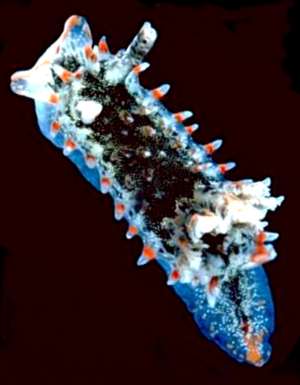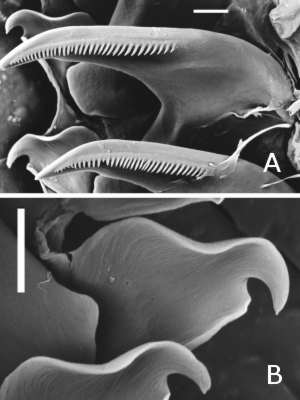Okenia echinata from eastern Australia
December 21, 2004
From: Bill Rudman


PHOTO: Upper. Arrawarra rock platform, Woolgoolga, New South Wales, Australia, 3 December 1990, [Photo only] AM C164553. Photo: Bill Rudman. Lower. SEM photos of the radula. A, left section of radula showing 2 large inner and 2 small outer teeth. B, close-up of two outer teeth on right side. Callala Point, Jervis Bay, New South Wales, Australia: 6 October 1975, 8 mm long preserved, AM C103287. Scale bar = 10 µm. Photo: G. Avern.
To accompany the new information being posted today on species of Okenia here is a photo of Okenia echinata, and its radula, from eastern Australia. Australian animals are translucent white with a many opaque white spots scattered over the dorsum. The dorsal surface has dark brown to black pigmentation, which in some animals gives the dorsum a uniform dark brown to black colouration and in other specimens appears as scattered dark brown to black patches, or even as regions of dark spotting. Scattered over this dark pigmentation are small opaque white spots. There is a broken orange line along the anterior edge of the head and oral lobes, and each of the translucent white mantle papillae has an orange band around its mid-region, although in some tubercles the orange band can reach to the tip. The gills are translucent white with some orange markings on the outside of the rachis. The rhinophores are translucent white with brown speckling, and often there is some orange speckling near the tip. The foot has a dark brown black band down the posterior midline which is replaced at the posterior tip by a patch of orange. There are also small white spots scattered all over the foot.
The original description of Okenia echinata from Japan, is rather different in colour, the animal being a uniformly brown animal with scattered white spots and triangular papillae. This colour pattern is rather different from that of animals from eastern Australia, but recent records on the Forum from Japan (message #8858; message #9146) show this species is very variable in colour.
The shape of the radulat teeth is typical of the goniodorids with a large inner tooth and a small outer tooth on each side of the midline in each row. The radular formula of the animal photographed was 18 x 1.1.0.1.1. The innermost tooth has a broad base and a long elongate pointed cusp with many narrow, relatively long, pointed denticles along the cutting edge. The much smaller outer teeth have a broad quadrangular base with a large recurved pointed cusp
- Rudman, W.B. (2004) Further species of the opisthobranch genus Okenia (Nudibranchia: Goniodorididae) from the Indo-West Pacific. Zootaxa, 695: 1-70.
Related messages
-
Re: Okenia echinata from Ratnagiri, India
From: Vishal Bhave, December 21, 2009 -
Re: Okenia echinata from Ratnagiri, India
From: Vishal Bhave, December 16, 2009 -
Okenia echinata from Ratnagiri, India
From: Vishal Bhave, December 15, 2009 -
Another Lophodoris? from Japan
From: Yuriko Taniguchi, September 8, 2009 -
Okenia echinata ? from Sth Korea
From: Dong Bum Koh, July 6, 2006 -
Okenia echinata? from Northern N.S.W.
From: Denis Riek, December 23, 2004 -
Re: Okenia echinata from Japan
From: Tomohiko Kurihara, February 11, 2003 -
Re: Okenia echinata from Japan
From: Jun Imamoto, January 20, 2003 -
Okenia echinata from Japan.
From: Jun Imamoto, January 18, 2003
